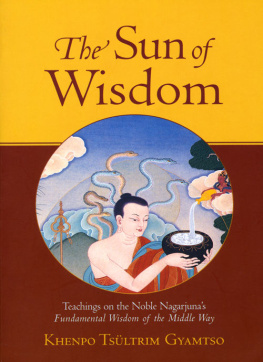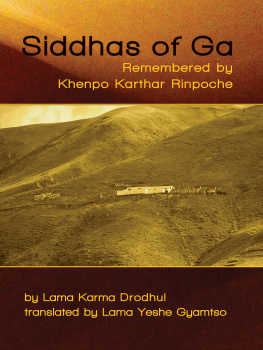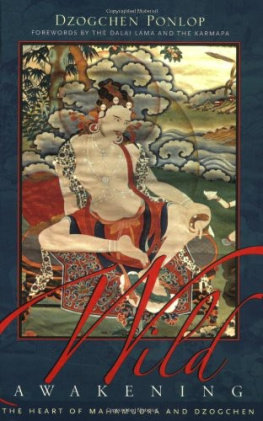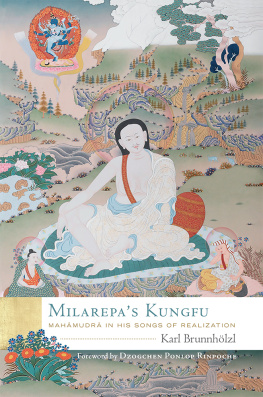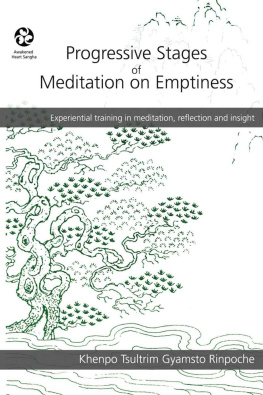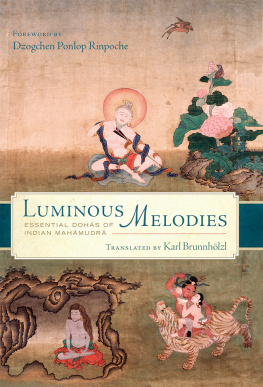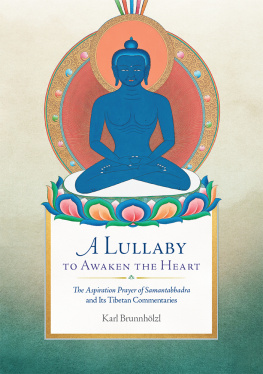When we consider the remarkable achievements of Khenpo Tsltrim Gyamtso Rinpoche and his contribution to the Dharma, he is, without doubt, one of the great guides of our time.
The Seventeenth Gyalwang Karmapa
A single word from a truly accomplished guru like Khenpo Rinpoche is worth a thousand pictures. These teachings will make an indelible imprint of nondual wisdom in the readers mind that no delete button of dualistic consciousness can undo.
Dzogchen Ponlop, author of Wild Awakening and Rebel Buddha
These teachings show us how the Buddhist path of view, meditation, and conduct can be practiced every day, all day, anywhere and everywhere. This book will instruct, delight, and inspire all who read it.
Elizabeth Callahan, translator of Jamgn Kongtruls Treasury of Knowledge: Frameworks of Buddhist Philosophy
ABOUT THE BOOK
Tibetan Buddhist master Khenpo Tsltrim Gyamtso is known for his joyful songs of realization and his spontaneous and skillful teaching style. In this book he explains how to gain clarity, peace, and wisdom through step-by-step analysis and meditation on the true nature of reality. He also introduces readers to the joy and profundity of yogic song, and reveals the power of aspiration prayers to inspire, transform, and brighten our hearts.
KHENPO TSLTRIM GYAMTSO is a noted Buddhist scholar and teacher who was born in Eastern Tibet in 1934. Known for his highly engaging teaching style, he has traveled and taught in North America, Europe, and Asia from 1977 to 2007. He is the author of The Sun of Wisdom , The Moon of Wisdom , and Progressive Stages of Meditation on Emptiness , and numerous songs of realization.
To learn more about the author, visit his website at www.ktgrinpoche.org.
Sign up to learn more about our books and receive special offers from Shambhala Publications.

Or visit us online to sign up at shambhala.com/eshambhala.
Stars of Wisdom

Analytical Meditation, Songs of Yogic Joy, and Prayers of Aspiration
K HENPO T SLTRIM G YAMTSO
Foreword by the Fourteenth Dalai Lama
Foreword by the Seventeenth Gyalwang Karmapa
Translated, Edited, and Introduced by
Ari Goldfield and Rose Taylor

S HAMBHALA Boston & London 2011
Shambhala Publications, Inc.
Horticultural Hall
300 Massachusetts Avenue
Boston, Massachusetts 02115
www.shambhala.com
2010 by the Marpa Foundation
Cover art by Jim Zaccaria
All rights reserved. No part of this book may be reproduced in any form or by any means, electronic or mechanical, including photocopying, recording, or by any information storage and retrieval system, without permission in writing from the publisher.
Library of Congress Cataloging-in-Publication Data
Khenpo Tsultrim Gyamtso, Rinpoche, 1934
Stars of wisdom: analytical meditation, songs of yogic joy, and prayers of aspiration / Khenpo Tsultrim Gyamtso; foreword by the Fourteenth Dalai Lama; foreword by the Seventeenth Gyalwang Karmapa; translated, edited, and introduced by Ari Goldfield and Rose Taylor.1st ed.
p. cm.
Includes index.
eISBN 978-0-8348-2295-5
ISBN 978-1-59030-775-5 (pbk.: alk. paper)
1. Spiritual lifeBuddhism. I. Goldfield, Ari, 1969 II. Taylor, Rose, 1970 III. Title.
BQ5675.K48 2010
294.3442dc22
2009034483
In the publication of this book, special thanks go to all of the sponsors of the Marpa Foundation. It is because of their generosity that we are able to publish this book of Khenpo Tsltrim Gyamtso Rinpoches wonderful teachings, and we are very grateful to them.
Contents



W E T IBETANS HAVE been custodians of the full range of the Buddhas teachings for well over a thousand years. These have been analyzed, refined, and most important of all put into practice, becoming the mainstay of Tibetan culture. Indeed, the principles of compassion and nonviolence are among the distinguishing marks of the Tibetan way of life even today.
Until 1959, many conditions contributed to the flourishing of Buddhism in Tibet. However, what gave it vigor was that down the centuries individuals continued not only to read, memorize, study, and debate, but also to retire to caves and other remote locations to meditate, just as great luminaries of the past, like Milarepa, had done. In the upheavals that followed 1959 the freedom to do this in Tibet has been severely constrained.
Khenpo Tsltrim Gyamtso Rinpoche is one of a steadily dwindling number of those who undertook their study and training in Tibet in the traditional way before everything changed in 1959. In his youth in Tibet he engaged in rigorous practice; in his middle years as a refugee in India he extended his studies to traditions other than his own Karma Kagyu; and later he has traveled and taught widely.
This book, Stars of Wisdom , contains Khenpo Rinpoches teachings on a variety of topics, including the path of reasoning, meditation on emptiness, the songs of Milarepa, and Mahayana aspiration prayers. It follows earlier commentaries on Nagarjunas and Chandrakirtis classic works. I have no doubt readers wishing to cultivate the Buddhist conduct and view will find much to inspire them here.

T ENZIN G YATSO
T HE F OURTEENTH D ALAI L AMA
May 27, 2009


W HEN WE CONSIDER the remarkable achievements of Khenpo Tsltrim Gyamtso Rinpoche and his contribution to the Dharma, he is, without doubt, one of the great guides of our time.
From a very young age he dedicated himself to the Dharma, and he has spent many years practicing diligently, following the example of other great masters of the Kagyu practice lineage.
I have always admired Rinpoches way of training his students. His approach is direct, sincere, and uncontrived, and he is not afraid to use unorthodox methods when necessary. I find this unique and commendable. Not only has he fostered a sangha of students, he has also produced many trained translators and hence made possible the dissemination of the teachings of the Kagyu lineage in many different languages.
We are living through turbulent times, and it is extremely difficult to find such an experienced practitioner and teacher. We are fortunate to have this great opportunity to listen to and read his teachings and commentaries and benefit from his wealth of experience.
The most important of a lamas activities is his speech, his teaching. Thus, it gives me great pleasure that efforts have been made to ensure that Rinpoches speech activity will be preserved for future generations by the publication of this collection of his teachings.
Next page

